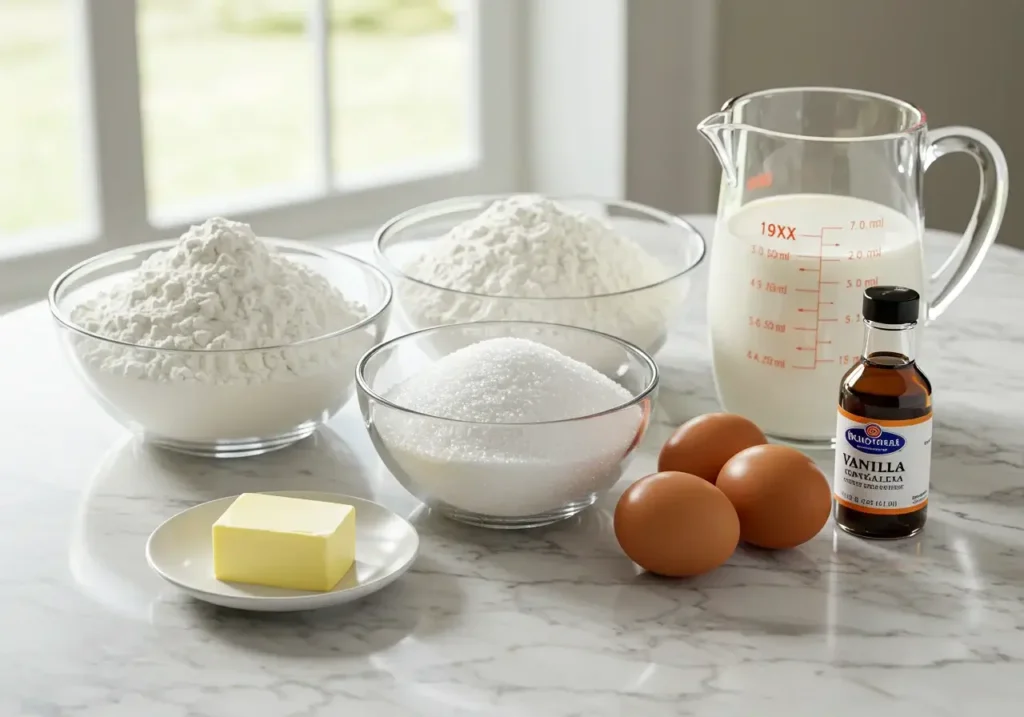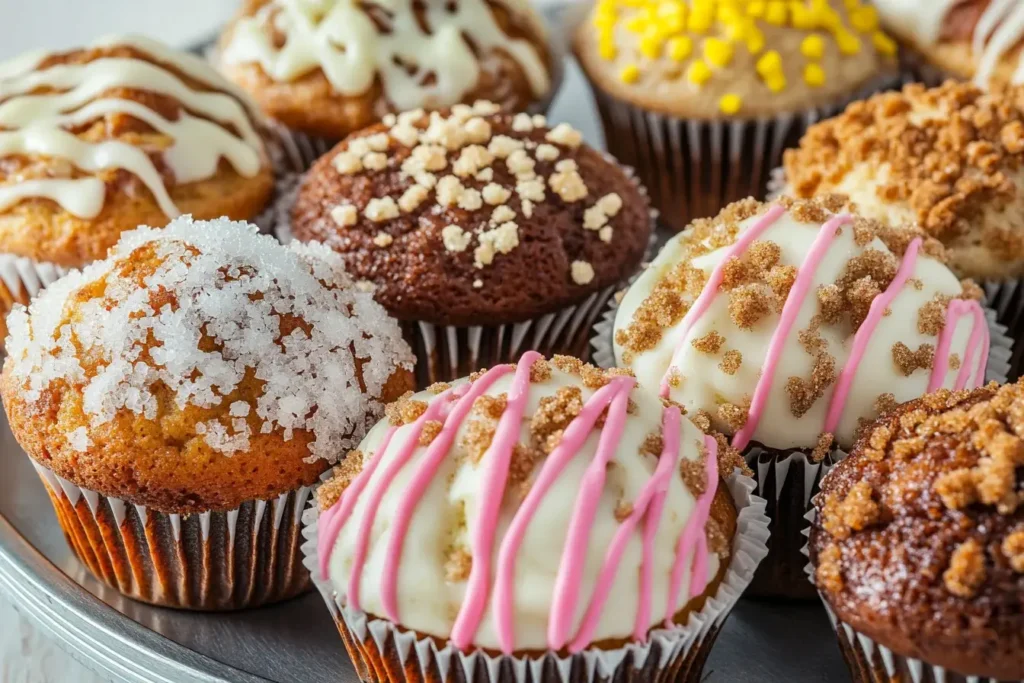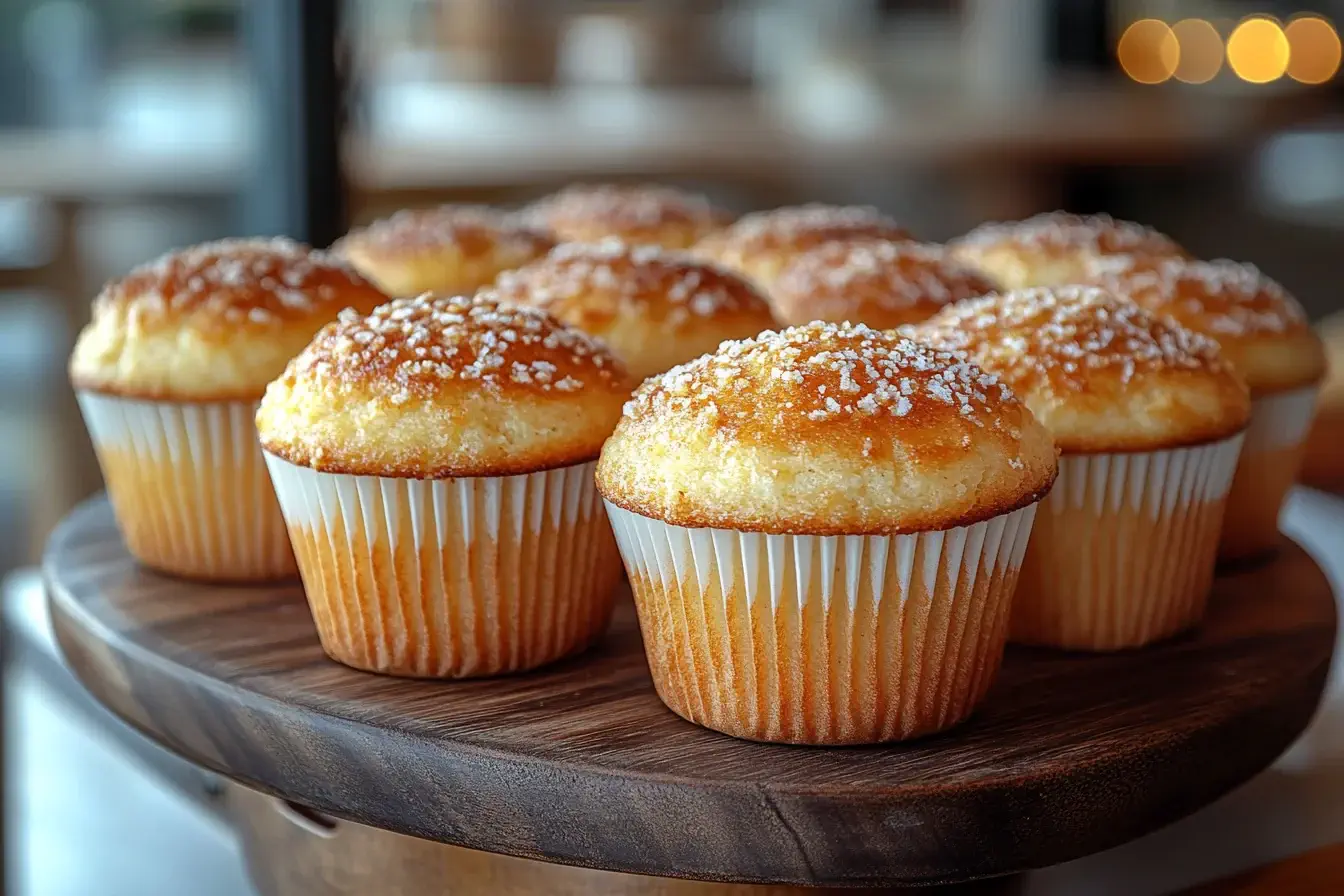Introduction
Have you ever bitten into a bakery muffin and thought, “Why can’t my homemade muffins taste this good?” You’re not alone! Bakery muffins have a way of combining moistness, perfect domes, and irresistible flavors that feel almost magical. But is there really a secret to their success?
In this article, we’ll explore what makes bakery muffins so special and how you can recreate that magic in your own kitchen. From ingredient quality and baking techniques to troubleshooting common mistakes, we’ll cover everything you need to know. Plus, we’ll dive into some expert tips that will elevate your muffins to bakery-level perfection.
Let’s uncover the secrets behind why bakery muffins are so much better.
The Allure of Bakery Muffins
What Makes Bakery Muffins Irresistible?
Bakery muffins aren’t just a breakfast treat—they’re a sensory experience. Their appeal begins with their flawless appearance. Who could resist those tall, golden-brown domes that seem to defy gravity? The texture is another draw: moist, tender, and just the right amount of crumbly. These muffins often feel like a special indulgence because they’re crafted to perfection, balancing richness and fluffiness in every bite.
The presentation plays a key role as well. Bakeries know how to display their muffins like works of art, often with tantalizing toppings like streusel, drizzles, or a generous sprinkle of sugar. Even before you take your first bite, bakery muffins captivate the senses.
The Art of First Impressions: Appearance and Texture
The hallmark of a great muffin is its dome. Bakery muffins rise high, creating that iconic rounded top that’s hard to replicate at home. This is achieved through a combination of proper leavening techniques and the use of high-quality ingredients.
But there’s more to it than looks. Bakery muffins have a melt-in-your-mouth texture that’s hard to beat. This comes down to their precise mixing methods—neither overmixed nor undermixed, but just enough to maintain structure while keeping the batter airy.
The Taste Advantage: Flavor Profiles That Captivate
Flavor is where bakery muffins truly shine. Whether it’s the burst of juicy blueberries, the comforting warmth of cinnamon, or the crunch of walnuts, bakery muffins boast layers of flavor that elevate them above homemade versions. Bakeries don’t skimp on quality add-ins, ensuring that every bite is packed with goodness.
Additionally, the subtle balance of sweetness and saltiness adds depth to the flavors, making bakery muffins feel indulgent without being overwhelming. It’s this attention to detail that keeps customers coming back for more.
Secrets Behind Bakery Muffin Perfection
The Science of Domed Muffins: Baking Techniques and Equipment
Ever noticed how bakery muffins always have that perfect, high-rise dome? It’s no accident! Professional bakers rely on a combination of precise techniques and specialized equipment to achieve this iconic look. One critical method involves starting the baking process at a high temperature—around 400°F (204°C). This gives muffins an initial burst of heat, causing the batter to rise quickly and form a beautiful dome.
Another secret lies in their tools. Commercial ovens distribute heat evenly, ensuring consistent baking. The use of nonstick muffin tins and parchment liners also plays a role in achieving a flawless finish.
For tips on achieving bakery-level results at home, check out this guide on the secrets of moist muffins.
Finally, the batter consistency matters. Professional bakers often create a slightly thicker batter, which supports the muffin’s structure as it rises.
Ingredient Quality and Ratios: The Bakery Advantage
When it comes to why bakery muffins are so much better, the quality of ingredients takes center stage. Bakeries prioritize premium components like fresh dairy, unbleached flour, and natural flavor extracts. These ingredients don’t just enhance the taste—they contribute to the texture and shelf life of the muffins.
The ratio of ingredients is another critical factor. Bakeries meticulously measure wet and dry components to ensure the perfect balance. For example, they often use more fat, such as butter or oil, to keep muffins moist and tender. A higher sugar content also caramelizes during baking, adding richness and a hint of crunch to the tops.
Mastering Moisture: What Bakeries Do Differently
One bite of a bakery muffin, and you’ll notice how moist it is. This is no coincidence. Professional bakers use techniques like adding sour cream, yogurt, or buttermilk to the batter. These ingredients not only boost moisture but also lend a subtle tang that enhances the flavor profile.
Another strategy is to avoid overmixing. Stirring the batter too much activates the gluten in the flour, leading to dense, dry muffins. Bakers mix just enough to combine the ingredients without compromising texture.
To learn more about maintaining perfect muffin moisture, visit this recipe on strawberry muffins, which incorporates fresh fruit for added moisture and flavor.
Common Challenges in Homemade Muffins
Why Homemade Muffins Fall Short of Bakery Standards
Many home bakers wonder, why are bakery muffins so much better than their own creations? One common reason is overmixing the batter. This seemingly small mistake can drastically affect the texture, making muffins tough and chewy instead of light and fluffy.
Another pitfall is using inferior ingredients. For instance, generic flavorings and low-quality flours can lead to lackluster results. Even the baking powder and soda must be fresh to achieve the proper rise.
Uneven oven heat is another challenge. Most home ovens have hot spots that can cause muffins to bake unevenly, resulting in lopsided tops or undercooked centers.
For tips on evenly cooking your baked goods, check out this practical guide on muffin-making mistakes.
How to Troubleshoot Baking Mistakes
If your muffins don’t turn out as planned, don’t despair—there are ways to troubleshoot! If they’re too dense, consider sifting the dry ingredients to incorporate more air. If they’re overly dry, try adding a touch more liquid or fat the next time.
Baking temperature is also crucial. Starting with a higher temperature for the first 5–7 minutes can help mimic the bakery dome effect. To improve texture, remember to let the batter rest for a few minutes before baking, allowing the dry ingredients to fully hydrate.
For more inspiration on creating perfectly balanced muffins, consider trying a moist muffin recipe with seasonal ingredients.
Recreating Bakery-Style Muffins at Home
Choosing the Right Ingredients: A Comprehensive Guide

If you want to bring the magic of bakery muffins to your kitchen, it starts with choosing the right ingredients. Opt for high-quality flour, such as unbleached all-purpose or even cake flour, to achieve a tender crumb. Using fresh baking powder or baking soda is critical to ensure proper rise.
Fats are another game-changer. Consider using real butter for a rich flavor, or a combination of butter and oil for both flavor and moisture. For liquid ingredients, buttermilk, whole milk, or sour cream work wonders to add depth and tenderness to the batter. And don’t forget the extracts—pure vanilla extract (instead of imitation) and fresh citrus zest can elevate the flavor profile dramatically.
If you’re curious about additional tips for ingredient selection, check out this strawberry muffin recipe for inspiration.
Baking Techniques for Perfection

Mastering bakery-style muffins isn’t just about ingredients—it’s about technique. Start by preheating your oven and setting it slightly hotter than the recipe suggests (about 400°F/204°C for the first few minutes) to encourage doming. After the initial heat burst, lower the temperature to finish baking evenly.
When mixing the batter, remember that less is more. Stir only until the ingredients are combined to avoid overdeveloping the gluten, which can make muffins dense. Using an ice cream scoop ensures consistent portion sizes, helping your muffins bake uniformly.
Additionally, let the batter rest for 10–15 minutes before baking. This step allows the leavening agents to activate fully, ensuring higher, fluffier muffins.
If you love muffins with extra toppings like streusel or sugar crystals, add them generously before baking for that irresistible bakery look.
A Deeper Look at Muffin Styles and Flavors
Popular Bakery Muffin Flavors: What Keeps Customers Coming Back?

When you walk into a bakery, the variety of muffins on display is often overwhelming—in the best way. Classic flavors like blueberry, banana nut, and chocolate chip continue to stand the test of time. Their simplicity appeals to a wide audience, offering comfort and familiarity with every bite.
Meanwhile, bakeries also experiment with trendy options to keep their menus fresh. Think lemon poppy seed, cranberry orange, or even savory muffins like cheddar jalapeño. These unique flavors cater to adventurous palates and create a sense of exclusivity.
To try your hand at a seasonal twist, you can check out a flavorful strawberry muffin recipe that’s perfect for warmer months.
Seasonal Muffins: Why Timing Matters in Muffin Magic
Seasonality plays a significant role in the allure of bakery muffins. Bakeries often use fresh, in-season fruits and spices to enhance flavor and appeal. For example, pumpkin muffins dominate autumn menus, while berries and citrus shine in spring and summer.
Using seasonal ingredients doesn’t just taste better—it can also be more economical. Fresh produce brings natural sweetness and vibrant flavors, which means you can use less sugar in the recipe. Plus, incorporating seasonal elements into your baking helps connect your muffins to specific times of year, creating nostalgia and excitement for your audience.
For readers who love exploring new recipes, check out the recipe section on Haven of Recipes for even more ideas to inspire your baking adventures.
FAQs About Bakery Muffins
Why Are Bakery Muffins Better?
The biggest question many people have is why are bakery muffins so much better than homemade ones? The secret lies in the combination of professional techniques, high-quality ingredients, and attention to detail. Bakeries use precise measurements, superior mixing methods, and premium components like fresh dairy and unbleached flour to create muffins with the perfect balance of moisture, texture, and flavor.
Additionally, commercial ovens distribute heat more evenly, resulting in consistent baking and those coveted domed tops. It’s this meticulous approach that makes bakery muffins stand out.
What Is the Secret to Bakery-Style Domed Muffins?
Achieving a bakery-style dome is all about technique. Professional bakers start by preheating their ovens to a higher temperature—around 400°F (204°C). This creates a burst of steam, which causes the batter to rise quickly and form a beautiful dome.
The consistency of the batter is also important. A slightly thicker batter provides more structure for the muffins to rise. And, of course, letting the batter rest for 10–15 minutes before baking helps activate the leavening agents for better results.
What Is the Secret to Making Moist Muffins?
Moist muffins start with the right ingredients. Adding fats like butter or oil, along with dairy products such as sour cream, buttermilk, or yogurt, keeps the batter rich and tender. Avoid overmixing, as this can make muffins dense and dry.
Another trick is to bake at the right temperature. Overbaking can dry out muffins, so keep a close eye on the timer and check for doneness with a toothpick.
What Is the Most Common Mistake When Making Muffins?
Overmixing is a frequent mistake that can ruin the texture of your muffins. Stirring too much develops the gluten in the flour, leading to tough, chewy results. For light and fluffy muffins, mix only until the ingredients are just combined.
Final Thoughts: Elevating Your Muffin Game
Key Takeaways from the World of Bakery Muffins
There’s no denying the appeal of bakery muffins. From their domed tops to their moist, tender centers, they’re a step above homemade muffins. The combination of premium ingredients, professional techniques, and creative flavors makes them irresistible. But with a little know-how, you can recreate this magic in your own kitchen.
Remember to invest in high-quality ingredients, use proper mixing techniques, and bake at the right temperatures to achieve bakery-worthy results. Experiment with flavors and toppings to personalize your muffins and make them stand out.
Encouragement to Experiment and Enjoy the Baking Journey
Baking muffins at home is as much about the process as it is about the outcome. Don’t be afraid to try new flavors, tweak recipes, or even embrace your baking mistakes—they’re all part of the learning experience.
With the tips shared in this article, you’re well on your way to making muffins that rival those from your favorite bakery. So, grab your mixing bowl, preheat your oven, and let the muffin magic begin!
Comparing Bakery Muffins to Store-Bought Muffins
The Bakery Muffin Edge
When comparing bakery muffins to their store-bought counterparts, the difference is immediately apparent. Bakery muffins often have a fresh, homemade quality that’s hard to replicate in packaged goods. They are baked in smaller batches, allowing for better attention to detail and the use of high-quality, fresh ingredients.
Store-bought muffins, on the other hand, are mass-produced. To extend shelf life, they often contain preservatives, artificial flavors, and stabilizers, which can detract from their taste and texture. The fluffy, moist texture of bakery muffins, achieved through careful mixing and premium components, stands in stark contrast to the dense or overly crumbly consistency of packaged varieties.
Taste and Texture: The Clear Winners
One of the most common reasons people wonder why are bakery muffins so much better is the superior taste and texture. Bakery muffins typically use real butter, fresh dairy, and natural flavorings. These ingredients provide a richer, more nuanced flavor that you simply can’t find in most store-bought options.
Texture is another key difference. The domed tops, tender crumb, and soft interiors of bakery muffins are a result of precise baking methods. Store-bought muffins often lack this attention to detail, leaving them with a generic taste and texture.
For those who value freshness and flavor, bakery muffins are the clear winners in this comparison.
Bringing the Bakery Experience Home
Creating a Bakery-Like Atmosphere

Part of the charm of enjoying bakery muffins is the ambiance that bakeries provide. While it may not be possible to replicate the entire bakery experience at home, you can create a cozy atmosphere to enhance your enjoyment. Brew a pot of fresh coffee or tea, serve your muffins on elegant plates, and set the mood with soft lighting or music.
Sharing the Muffin Love
Another way to bring the bakery experience home is to share your muffins with family and friends. Homemade muffins, when crafted with care, can rival those from professional bakeries. Hosting a brunch or tea party featuring your creations is a delightful way to showcase your baking skills and share the joy of freshly baked goods.
For more baking ideas and inspiration, consider checking out recipe collections online or exploring new flavor combinations in your kitchen. With practice and creativity, you’ll soon understand why bakery muffins are so much better—and how to make them just as good at home.

